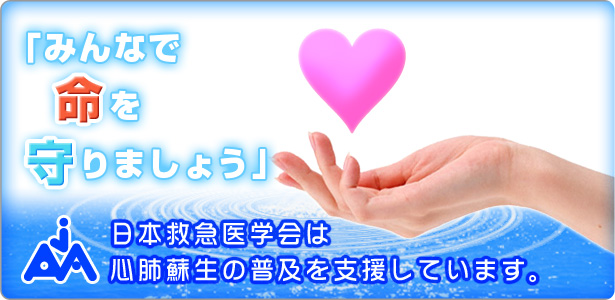心臓の働き
心臓は、血液を全身に送り酸素や栄養を運ぶ筋肉でできたポンプです。心臓は1分間に約70回、1日にしておよそ10万回、24時間365日休むことなく動いているのです。

心停止とは?
心停止とは心臓が止まってしまった状態です。心臓が止まると、全身に血液が回らなくなってしまいます。脳に血が回らなくなり、数秒で意識・反応がなくなります。そして、息もなくなってしまいます。
みなさんの協力が必要な理由
- 心臓病による死亡の多くは病院の外で突然起こる心臓突然死です1)。日本では毎年5万人以上が心臓突然死で亡くなっています2)*。
- 病院外の心停止の救命率は、救急救命士制度の充実などの病院外での救急システムの改善によって改善してきていますが、未だに低いのが現状です2)-5)。
- 心臓突然死は、心臓が細かくふるえる心室細動と呼ばれる不整脈から引き起こされることが多く、心臓の動きを戻すには少しでも早く電気ショックを行う必要があります6)。突然倒れてから電気ショックが1分遅れるごとに救命率は約10%ずつ下がっていきます2)3)7)8)。
- 一般市民がAEDを使用することで、救命率が約2倍高まります2)9)。
- 心停止からの救命には、少しでも早く助けを求め、AEDを取り寄せるとともに、絶え間ない胸骨圧迫を行うことが重要です6)7)10)。
少なくとも胸骨圧迫を!子供の心臓以外が原因の心停止では人工呼吸を!
- 心肺蘇生は、胸骨圧迫と人工呼吸の組み合わせが原則ですが、強く・早く・絶え間ない胸骨圧迫が最も重要です。特に成人の場合において、心臓が原因の心停止では、胸骨圧迫のみの心肺蘇生でも、人工呼吸つきの従来の心肺蘇生と同等もしくはそれ以上の効果があることが分かってきました2)11)-15)。胸骨圧迫のみの蘇生法は覚えやすく、人工呼吸がない分心肺蘇生実施への抵抗感が減り、心肺蘇生の普及、救命率の向上に役立つと期待されます15)-19)。
- 子どもの心停止では、窒息や溺水(できすい)などの呼吸が止まることによる心停止が多く、こうした場合、胸骨圧迫と人工呼吸との組み合わせがより有効であると分かってきました20)。
≪参考文献≫ クリックすると文中の番号の資料が表示されます。
- Lowel H, Dobson A, Keil U, et al. Coronary heart disease case fatality in four countries. A community study. The acute myocardial infarction register teams of Auckland, Augsburg, Bremen, FINMONICA, Newcastle, and Perth. Circulation 1993;88:2524-2531.
- Kitamura T, Iwami T, Kawamura T, et al; for the Implementation Working Group for All-Japan Utstein Registry of the Fire and Disaster Management Agency. Nationwide public access defibrillation in Japan. New Engl J Med 2010;362:994-1004.
- Iwami T, Nichol G, Hiraide A, et al. Continuous improvements in chain of survival increased survival after out-of-hospital cardiac arrests: a large-scale population-based study. Circulation 2009;119:728-734.
- Eckstein M, Stratton SJ, Chan LS. Cardiac Arrest Resuscitation Evaluation in Los Angeles: CARE-LA. Ann Emerg Med 2005;45:504-509.
- Lombardi G, Gallagher J, Gennis P. Outcome of out-of-hospital cardiac arrest in New York City. The Pre-Hospital Arrest Survival Evaluation (PHASE) Study. JAMA 1994;271:678-683.
- 日本版救急蘇生ガイドライン策定小委員会編.【改訂3版】救急蘇生法の指針(市民用・解説編). へるす出版.2006
- 2005 American Heart Association guidelines for cardiopulmonary resuscitation and emergency cardiovascular care. Circulation 2005;112(24 Suppl.):IV1-203.
- Larsen MP, Eisenberg MS, Cummins RO, et al. Predicting survival from out-of-hospital cardiac arrest: a graphic model. Ann Emerg Med 1993;22:1652-1658.
- Weisfeldt ML, Sitlani CM, Ornato JP, et al. Survival after application of automatic external defibrillators before arrival of the emergency medical system: evaluation in the resuscitation outcomes consortium population of 21 million. J Am Coll Cardiol 2010;55:1713-1720.
- Yu T, Weil MH, Tang W, Adverse outcomes of interrupted precordial compression during automated defibrillation. Circulation 2002;:368-372.
- SOS-KANTO study group. Cardiopulmonary resuscitation by bystanders with chest compression only (SOS-KANTO): an observation study. Lancet 2007;369:920-926.
- Iwami T, Kawamura T, Hiraide A, et al. Effectiveness of bystander-initiated cardiac-only resuscitation for patients with out-of-hospital cardiac arrest. Circulation 2007;116:2900-2907.
- Bohm K, Rosenqvist M, Herlitz J, et al. Survival is similar after standard treatment and chest compression only in out-of-hospital bystander cardiopulmonary resuscitation. Circulation 2007;116:2908-2912.
- Ewy GA. Continuous-chest-compression cardiopulmonary resuscitation for cardiac arrest. Circulation, 2007;116:2894-2896.
- Sayre MR, Berg RA, Cave DM, et al. Hands-only (compression-only) cardiopulmonary resuscitation: a call to action for bystander response to adults who experience out-of-hospital sudden cardiac arrest: a science advisory for the public from the American Heart Association Emergency Cardiovascular Care Committee. Circulation, 2008;117:2162-2167.
- Hallstrom A, Cobb L, Johnson E, et al. Cardiopulmonary resuscitation by chest compression alone or with mouth-to-mouth ventilation. N Engl J Med 2000;342:1546-1553.
- Nishiyama C, Iwami T, Kawamura T, et al. Effectiveness of simplified chest compression-only CPR training for the general public: a randomized controlled trial. Resuscitation 2008;79:90-96.
- Shibata K, Taniguchi T, Yoshida M, Yamamoto K. Obstacles to bystander cardiopulmonary resuscitation in Japan. Resuscitation. 2000 3:187-93.
- Taniguchi T, Omi W, Inaba H. Attitudes toward the performance of bystander cardiopulmonary resuscitation in Japan. Resuscitation. 2007 1:82-7
- Kitamura T, Iwami T, Kawamura T, et al; for the Implementation Working Group for All-Japan Utstein Registry of the Fire and Disaster Management Agency. Conventional and chest-compression-only cardiopulmonary resuscitation by bystanders for children who have out-of-hospital cardiac arrests: a prospective, nationwide, population-based cohort study. Lancet 2010;375:1347-1354.
*総務省消防庁救急企画室 救急統計活用検討会ウツタイン作業部会
(http://www.fdma.go.jp/html/data/tuchi2203/pdf/220318_NEJM.pdf)
 このページの先頭へ
このページの先頭へ




















 このページの先頭へ
このページの先頭へ